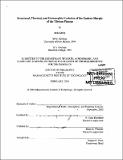Structural, thermal, and geomorphic evolution of the eastern margin of the Tibetan Plateau
Author(s)
Kirby, Eric
DownloadFull printable version (20.30Mb)
Other Contributors
Massachusetts Institute of Technology. Dept. of Earth, Atmospheric, and Planetary Sciences.
Advisor
B. Clark Burchfiel.
Terms of use
Metadata
Show full item recordAbstract
The eastern margin of the Tibetan Plateau adjacent to and north of the Sichuan Basin poses a fundamental geodynamic problem; the topography of eastern Tibet apparently developed in the absence of significant shortening of the upper crust. This study investigates the development and subsequent evolution of the topographic margin of the plateau in an effort to ascertain the controls on and geodynamic significance of present day topography. The primary results from this study are threefold, and include: 1) an estimate of the inception of high relief along the plateau margin in the Late Miocene; 2) documentation of active deformation in the Min Shan range and estimates of the rates and pattern of Pleistocene-Recent rock uplift; 3) an assessment of the controls on the spatial distribution of bedrock channel gradients in this landscape. Thermal histories of rocks along the margin inferred from *Ar/39Ar and (U-Th)/He thermochronology provide constraints on the long-term rates and distribution of denudation across this margin of the plateau. Results indicate that 1) prior to the Late Miocene (ca. 11 Ma) regional denudation rates were low (< 0.1 mm/yr), and 2) rocks adjacent to the plateau margin were exhumed from depths of 8-10 km since that time. Active deformation and rock uplift in the Min Shan is documented by tilted Pleistocene basins along the western range flank. Geologic mapping and chronology demonstrate that rates of tilting are rapid (~108 rad/yr), and that rock uplift is highest near the range crest. However, mapped faults adjacent to the range do not appear to exert a direct control on the distribution of rock uplift. Analysis of bedrock river longitudinal profiles reveals a region of steep channels (normalized for drainage area) adjacent to the topographic front of the plateau margin. The spatial distribution of channel steepness appears to reflect active rock uplift focused along the plateau margin. Thus, the high topography along the plateau margin is argued to be a dynamic response to rock uplift in the absence of significant horizontal shortening and may reflect thickening in the lower crust.
Description
Thesis (Ph.D.)--Massachusetts Institute of Technology, Dept. of Earth, Atmospheric, and Planetary Sciences, February 2001. Includes bibliographical references.
Date issued
2001Department
Massachusetts Institute of Technology. Department of Earth, Atmospheric, and Planetary SciencesPublisher
Massachusetts Institute of Technology
Keywords
Earth, Atmospheric, and Planetary Sciences.